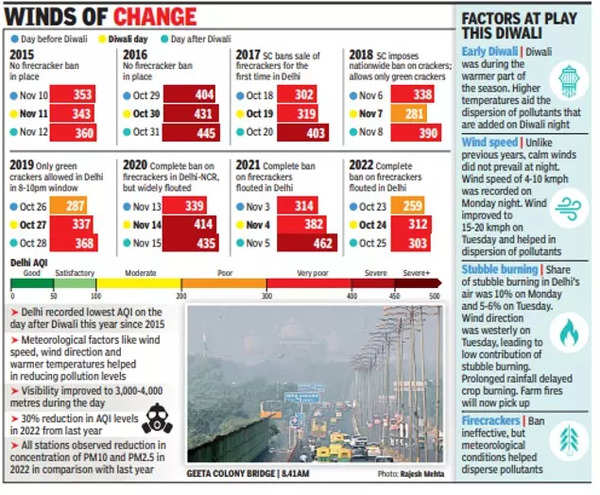Track the pollution level in your city
Delhi’s 24-hour AQI was 303 on Tuesday, in ‘very poor’ zone, but slightly better than the previous day’s reading of 312. In terms of AQI, this was a 30% reduction compared to the post-Diwali day of 2021.

Experts attributed the improvement to weather conditions, particularly the effect of Cyclone Sitrang that crossed Bangladesh on Monday and warmer temperatures on account of Diwali coming relatively early this year.
Visibility of 4km ‘rare’ on day after Diwali
Meteorological conditions came to the aid of Delhiites after a cracker-filled Diwali, with dry westerly winds at speeds of 4-10kmph on Monday night, and 8-16kmph on Tuesday, helping drain out pollutants from the region. The visibility during the day was recorded at 3,000-4,000 metres and Met officials said such visibility a day after Diwali was “rare”.
Wind speeds even helped improve AQI further as real-time AQI reached “poor” category at 7pm on Tuesday with a reading of 298 on the index.
A report prepared by Delhi Pollution Control Committee on assessment of air quality during Diwali said, “Overall percentage reduction observed in city’s average concentration of PM10 is 57% and PM2.5 is 64% in 2022 as compared to 2021. Overall ambient air quality found to be better than the previous year.”
System of Air Quality and Weather Forecasting And Research (SAFAR) said the share of stubble burning to Delhi’s air was 10% on Monday and 5-6% on Tuesday. As the wind direction changed to westerly on Tuesday, the impact of farm fires was low. DPCC in its report said, “Temperature was also one of the significant factors this year. Less bursting of firecrackers in year 2022 could also be an important reason as compared to year 2021.”
CPCB’s data shows that the AQI on Sunday (pre-Diwali) was 262 in “poor” category, which deteriorated to 312 in “very poor” category on Diwali day. Before Diwali, the last time Delhi had reported a “very poor” air day was on June 10, with an AQI of 303.
In contrast, 2021 saw deterioration in AQI from 382 on Diwali day to 462 in “severe” category the day after. In 2020, the air quality remained in “severe” category on both Diwali and the next day.
Anumita Roychowdhury, executive director research and advocacy, Centre for Science and Environment, said, “As expected, the combination of warmer climate, favourable meteorological conditions with higher wind speed, lesser stubble burning created conducive atmosphere and prevented trapping of smoke and pollutants.”
However, experts emphasised the need to reduce the use of firecrackers. Aarti Khosla, director, Climate Trends said, “It’s good news from Delhi with significantly lower pollution levels. The crackers ban went up in smoke, but it was the combination of factors that led to this seemingly improved air quality which we haven’t seen in the past years. The levels, however, remained above safe limits. If we as citizens reduce use of firecrackers, we are not only part of the solution but also part of leaving a civilisational legacy.”
Welcoming the lower level of pollution observed in this Diwali, chief minister Arvind Kejriwal tweeted, “Delhiites are working hard in the field of pollution. There have been very encouraging results but there is still a long way to go. We will make Delhi the best city in the world.”





